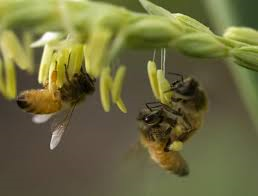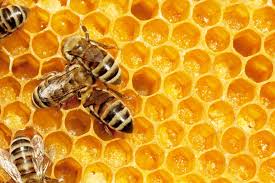Although fear is the most common reaction to bees, most people deal with them because they are aware of the benefits and natural services they provide. Gardeners love bees because they will pollinate their crops and vegetables which is required for most fruits and vegetables to begin their cycle of growth. Food lovers tolerate bees because of the sweet substance of honey is just so very tasty. What most people don’t know, is that bees produce other natural products that have been used for centuries in treating infections and the spread of disease. Bee propolis, is just one of those products.
What is Bee Propolis?
 It is a resinous substance occurring naturally in the buds and barks of many trees. This sticky ooze, is gathered by bees and blended with their own wax and used with the construction and building of their hives. It can be golden in color, but also range from reds, browns, greens, and blacks. It depends on the actual raw material being used. Bees use this material in much the same way we use caulk in our homes. Because of its stickiness it is used to seal gaps in the hive, but its strength also makes it an excellent reinforcement.
It is a resinous substance occurring naturally in the buds and barks of many trees. This sticky ooze, is gathered by bees and blended with their own wax and used with the construction and building of their hives. It can be golden in color, but also range from reds, browns, greens, and blacks. It depends on the actual raw material being used. Bees use this material in much the same way we use caulk in our homes. Because of its stickiness it is used to seal gaps in the hive, but its strength also makes it an excellent reinforcement.
Propolis has been harvested and used by humans for centuries, mostly in the world of medicine. Among its uses have been to treat burns, a remedy for sore throats, and to treat canker sores. The most notable use, however, depends on the natural anti-microbial properties of bee propolis. As an antibiotic, its effectiveness has stood up to even the scrutiny of traditional medicine.
Health Benefits of Bee Propolis
 According to Dr. Mahmoud Lotfy, many studies have shown that the propolis is very effective in the following conditions:
According to Dr. Mahmoud Lotfy, many studies have shown that the propolis is very effective in the following conditions:
* Anti-bacterial
In a study done by Glinick and Gapanovich, they tested the use of propolis in the treatment of chickens using 161 different strains of Staphylococcus aureus. What they found is that the propolis was effective in treating the infection even when the bacterium was resistant to antibiotics such as penicillin, tetracycline, and erythromycin. Common infections, in people, that are caused by Staphylococcus aureus are, skin infections, pneumonia, deep tissue infections, and toxic shock syndrome.
*Anti-fungal
Kovalik (1979) investigated 12 patients suffering from chronic sinusitis, caused by Candida albicans. It was discovered that the fungus was sensitive to propolis in 10 of the cases. The patients were all treated with an alcohol-oil mixture of propolis. After 1-2 treatments with propolis, there was an improvement in the condition of patients. After 5-8 treatments, clinical recovery occurred in nine patients and improvement in the other three patients. All of them fully recovery occurred after 10-17 days.
* Anti-inflammatory
The use of propolis was tested, by Park and Kahng in rats with arthritis to show its anti-inflammatory effects. The results showed improvement in the treatment of chronic and acute arthritis. Furthermore, it showed that the pain relief effect was as good as using prednisone and aspirin.
*Anti-tumor
In another study using this propolis from Brazil, the researchers were able to show that the growth of tumor cells could be inhibited, most noticeably in carcinoma and malignant melanoma. In addition, to its effects on tumors, in this study, they also discovered the great effect it had on boosting the immune system. This is exciting one considers that the 3rd leading cause of death in humans is cancer.
Additionally, many other countless studies have shown evidence of bee propolis being effective in treating viral and parasite infections. It has also shown promise its protective effects on the brain, heart and liver. It also seems able to lower blood pressure and cholesterol levels and improve sugar levels in diabetes.
Propolis is available in a wide assortment of products found in pharmacies and health food stores, including tablets, capsules, powders, extracts, ointments, creams, lotions, and other cosmetics. The ointment is especially effective for treating wounds and preventing infections. It is said to work by preventing bacteria from reproducing and breaking down their cell walls. It is also shown as effective against viruses, but the exact mechanism for this is not yet verified.
With all these great health benefits, it would be a great idea for a person to consider use of bee propolis to help maintain good health as well as aid in the treatment of health problems. However, it is important to remember that before the use of any supplement is started, a person should always consult their healthcare provider.
Additional Information
Propolis can be harvested and used raw, but this is a difficult process. It must first be found, recognized, and carefully removed from the wax structures of the hive. But once you have a raw propolis, it can be used orally by rolling small pieces into small ball-shaped pellets that can be swallowed. Because of it’s stickiness, it can also be applied directly to open cuts and wounds. It is recommended, however, that the refined and cleaned propolis in store-bought pills and ointments be used instead. These preparations have been prepared especially for their ease of application. These products can be bought online or at nearly every health-food store in the country.
If you are trying to watch your chemical intake and are untrusting of many pharmaceuticals, bee propolis is a step in the right direction. If you are sensitive to honey or other bee products, do not use propolis. Negative reactions are often stronger than with other bee products. If you have no known sensitivity, then by all means use it in both the oral forms, for health maintenance, and topical forms for more immediate concerns for infection.
Other Names
Its many other names include: Acide de Cire d’Abeille, Baume de Propolis, Bee Glue, Bee Propolis, Beeswax Acid, Cire d’Abeille Synthétique, Cire de Propolis, Colle d’Abeille, Hive Dross, Pénicilline Russe, Propóleos, Propolis Balsam, Propolis Cera, Propolis d’Abeille, Propolis Resin, Propolis Wax, Résine de Propolis, Russian Penicillin, Synthetic Beeswax.
NOTE:
I ) Propolis is created from resins, balsams and tree saps. Honey bees which nest in tree cavities use it to seal cracks in the hive. Dwarf hone bees use it to defend against ants by coating the branch from which their nest is suspended to create a sticky moat.
2) Some individuals are hypersensitive to propolis especially with hypersensitive skin; even though it is know for its low toxicity.
3) Honey, was the first sweetener known to man. It is frequently mentioned in the Bible and depicted in cave paintings from prehistoric times. Early civilizations, like the Ancient Greeks and Romans, called honey, “the nectar of the gods”. It has been said that honey bees were not native to North America; and that early settlers brought bee colonies to the East Coast States.
ARTICLE SOURCES AND CITATIONS
- http://news.bbc.co.uk/earth/hi/earth_news/newsid_8152000/8152574.stm
- http://www.webmd.com/vitamins-supplements/ingredientmono-390-PROPOLIS.aspx?activeIngredientId=390&activeIngredientName=PROPOLIS
- http://www.apocpcontrol.org/paper_file/issue_abs/Volume7_No1/Lotfy.pdf
- http://emedicine.medscape.com/article/971358-clinical

